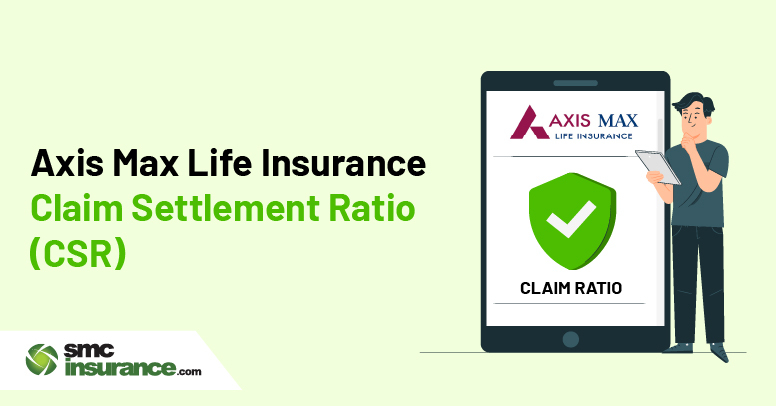Axis Max Life Insurance Company’s
Key Features and Benefits
Axis Max Life Insurance Company has been in the insurance market for quite some time now. It actually started out as Max New York Life Insurance Company Limited but changed its name later. Today, it's one of the better-known life insurance providers in India.
The company was set up back in 2000. It's a joint venture between Max Financial Services and Axis Bank. The main office is in New Delhi, and the company is currently led by Mr. Prashant Tripathy, who’s the CEO and CMD.
Over the years, Axis Max Life has built a solid presence in the insurance space. People know it for offering a range of plans that cover different needs like term insurance, savings plans, and more. The idea is to help individuals and families stay financially secure, especially when life takes an unexpected turn.
The following are some of Axis Max Life Insurance Company's salient features:
| Founded In |
|
| Turnover (GWP) |
|
| Number Of Policies |
|
| Number Of Claims |
|
| Claim Settlement Ratio |
|
| % Of Complaints Received on Overall Claims |
|
| % Of Complaints Received for After-Sales Service |
|
| Claims Settled in Less Than 30 Days |
|
(Source: Axis Max Life Insurance Company’s website and Public Disclosure for the financial year 2023-2024).
What the
Claim Settlement Ratio
Doesn’t Tell You?
A lot of people check and review the Claim Settlement Ratio (CSR) when judging how reliable an insurance company is. And sure, it gives you a rough idea of how many claims are getting paid. But here’s the thing: it doesn’t tell you everything. In fact, depending only on CSR might leave you with a false sense of security. Here's why:
1
Your Claim Isn’t Guaranteed
A high CSR just means the company paid out most claims overall. That’s it. It doesn’t mean your claim will be accepted. You might think you’re in the clear just because the percentage looks good, but each claim is different. A lower CSR doesn’t always mean your claim will be denied, either. That part often gets overlooked.
2
No Information on How Much Was Paid
CSR tells you how many claims were settled and not the total value of claims that was actually paid. A company could have a high CSR but still be paying mostly smaller claims, while delaying or rejecting larger ones. Without knowing the value of claims, you’re only getting part of the picture.
3
No Idea How Long It Takes
Getting a claim approved is one thing. Waiting for the payout to actually come through is another. CSR doesn’t tell you how long it takes to get paid. A company might have a great CSR but still take weeks (or longer) to release the funds. And that delay can be stressful when you’re already going through a tough time.
4
Doesn’t Show the Claims Experience
A smooth claim process also matters a lot. Filing a claim should be a simple process. Communication should be clear and support should be there when you need it. CSR doesn't measure any of that. So even if a company scores high, the actual experience might still be frustrating or confusing.
5
No Insight into Financial Judgment
A good insurance provider doesn't just pay claims; it also needs to be smart about spotting fraud. That kind of financial discipline helps protect the business and its policyholders in the long run. But CSR doesn’t reflect any of this. It can’t tell you if a company is being fair and cautious at the same time.
6
Mixes All Types of Claims
Most CSR numbers are pulled from all the company’s products - life, health, savings, and more. That means the number might reflect performance from unrelated policies. For example, if you're only interested in life insurance, it’s hard to know how that specific area is doing unless the nitty gritty details are broken down.
So, is CSR helpful? Sure, but it doesn’t stand on its own. A high CSR doesn’t mean better service, faster payouts, or that you can blindly trust the company. You need more context to make a smart choice.
Now, with that in mind, let’s take a closer look at Axis Max Life Insurance’s Claim Settlement Ratio and what it actually tells us.
What Is Axis Max Life Insurance Claim Settlement Ratio?
The claim settlement ratio of Axis Max Life Insurance Company as of March 2024 is 99.65%. (Source: Public Disclosure, FY-2023-24).
Claim Process of Axis Max Life Insurance Company
Picking the right life insurance policy is important but knowing how the claim process works is just as crucial. Axis Max Life Insurance Company has kept things fairly simple, with three main types of claims:
➔ Death Claim
This type of claim is made when the person insured under the policy passes away while the policy is still active. The nominee (usually a close family member named in the policy) can then apply to receive the death benefit. The exact amount paid out depends on the type of policy and the terms that were agreed on.
So, how does the process actually work? Here’s a basic breakdown:
- Step 1: Inform the Company
The first thing the nominee needs to do is notify Axis Max Life Insurance about the death. There are a few ways to do this either through their website, by email or SMS, by calling their toll-free number, or by visiting the nearest branch.
- Step 2: Submit the Documents
After informing the company, the nominee has to send in the required documents. This includes a duly filled-out claim form along with all the supporting paperwork.
Once everything is submitted, the company sends a system-generated acknowledgement confirming they’ve received the documents. It’s a good idea for the nominee to keep a scanned copy of everything, just in case it’s needed later. The actual claim review won’t begin until all documents are in. Once that happens, the insurer begins the process of verifying everything and moving the claim forward.
- Step 3: Providing Additional Information
Sometimes, the insurance company may ask for extra documents before they can move forward with the claim. Usually, they’ll reach out by email or through other official channels. It’s important for the nominee to respond quickly—any delay can slow down the whole process.
So, what might they ask for? Here's a quick breakdown:
-
- Basic Documents (Usually Needed for Most Death Claims)
- A filled-out claimant statement form
- A self-attested copy of the death certificate
- The nominee’s KYC (self-attested copy)
- Bank account details of the nominee
- If the Claim Is Made Within the First 3 Years of the Policy
For newer policies, a few more things might be required:
-
-
- The original policy document
- Certificate from a medical attendant, if there was one
- Self-attested copies of medical reports or treatment history
- A certificate from the employer, if applicable
- For Accidental or Unnatural Death
In cases involving accidents or unnatural causes, the list gets more detailed:
-
-
- Valid vehicle insurance papers (if it was a road accident)
- Driving licence (if the policyholder was driving at the time)
- Post-mortem report
- FIR and final police closure report
- Police inquest report or Panchnama
- Newspaper clippings, if any are available
- Step 4: Approval and Payment
Once all the required documents are submitted, the insurance company reviews everything carefully. If anything is missing or seems off, there’s a chance the claim could be delayed or even rejected.
But if everything looks fine and the selected payout method is available, the approved claim payout is sent to the nominee. It’s the final part of the process and reflects the company’s role in supporting your family during a tough time.
➔ Maturity Claim
A maturity claim comes into play when the policyholder reaches the end of the life insurance policy term. Basically, if you've stayed covered for the full duration, the insurance company gives you a maturity payout. The payout you get depends on the type of policy and the terms you agreed to when you first signed up the policy.
How to Make a Maturity Claim
The process is pretty straightforward. Here’s what you need to do:
- Reach Out to the Insurance Company
Start by getting in touch with your insurer. You can visit the nearest branch office to let them know you want to file a maturity claim. Having all the right documents with you will make things easier and quicker.
- Submit the Required Documents
You’ll need to hand over a few basic documents to start the process:
-
- The original policy document
- A completed claim or payout form
- Document Check
Once the papers are in, the insurer will go through them to confirm everything is in order. This step helps make sure you’re eligible to receive the maturity amount.
- Payment
If all is good and the claim is approved, the maturity amount gets deposited into your registered bank account. Most of the time, this happens within 30 days. If there’s any issue or if the claim gets rejected for some reason, the company will get in touch with you by phone, SMS, or email to explain what went wrong.
➔ Rider's Claim
Think of a rider as using an extra layer of protection that enhances your base life insurance policy. Riders are optional add-ons you choose based on your needs. They kick in during specific situations like if you’re diagnosed with a critical illness, suffer a disability, or in the case of accidental death. They’re meant to give your coverage a bit more flexibility based on your life and what matters most to you.
How the Rider Claim Process Works
The steps for making a rider claim depend on what kind of rider you’ve chosen and what the insurance company asks for. But here’s a general idea of how it usually goes:
Example Scenarios:
- If you're claiming a Critical Illness Rider, you’ll need a confirmed diagnosis of a listed illness and must meet any waiting or survival periods stated in the policy.
- If your family is filing an Accidental Death Benefit Rider claim, the cause of death must be an accident, and it needs to fall within the timeframe set in the policy.
Basic Steps in the Rider Claim Process
- Let the Insurer Know
The first step is to inform the insurance company as soon as possible. It could be you or a family member, depending on the situation. Early notification to the insurer helps move things along faster.
- Send the Required Documents
Once the claim is reported, the next step is to provide all the necessary paperwork. The documents needed vary based on the rider type, so it’s best to double-check what applies to your case.
- Review and Processing
After receiving the documents, the insurer will go through everything to confirm the details. If all checks out, they’ll process the claim accordingly.
Important Note: Not all companies follow the same steps and regulations can change often. The type of rider you own and the fine print in your policy makes a big difference. So always go through your policy document carefully or contact the insurer directly if you’re unsure of what to do.
How to Track Your Axis Max Life Insurance Claim Status?
You can track your Max claim status here – https://www.maxlifeinsurance.com/customer-service/claims-tracker
You can also call 1860 120 5577 to speak directly with a customer service rep. They'll walk you through the steps and help you out with the process.
To Sum Up,
As of March 31, 2024, Axis Max Life Insurance has a claim settlement ratio of 99.65%. This reflects the company’s efforts to support its policyholders when it matters. But don’t base your entire decision just on CSR. Yes, it’s a good indicator but it doesn’t show the full picture. Other factors also matter, like how smooth the claim process is, how quickly claims are settled, and what kind of support you get during the process.
That’s where SMC comes in. They make the whole thing less confusing by giving you clear guidance, useful features and the help you need to choose wisely. With SMC in your corner, you're not just buying an insurance plan, you’re making sure someone’s got your back throughout the journey.
FAQ
Axis Max Life Insurance is known for settling claims quickly. In the financial year 2023–2024, the company cleared 99.80% of claims within 30 days.
(Source: FY 2023–2024 Public Disclosure)
As of March 2024, the company has a Claim Settlement Ratio of 99.65%. That shows a strong track record when it comes to handling claims consistently and fairly.
(Source: FY 2023–2024 Public Disclosure)
Yes, claims should ideally be made within 90 days of the person’s death. That said, Axis Max Life Insurance understands delays can happen due to genuine reasons. If the delay isn't due to carelessness, the insurer may still accept the claim. Still, it’s best to inform the company as early as you can to keep things smooth.








 Taxi Insurance
Taxi Insurance

